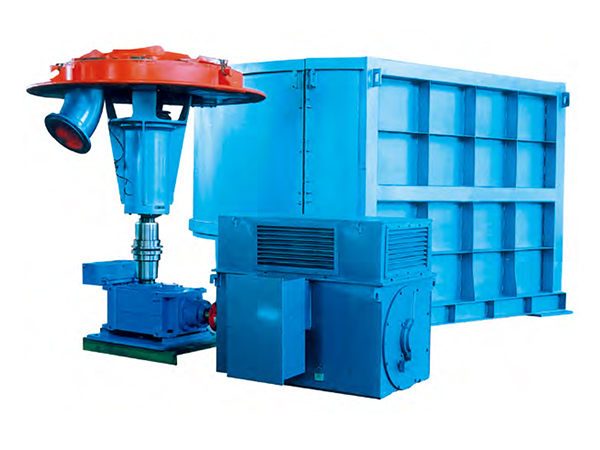In the fields of pulp and paper making and waste paper recycling, the pulper is the core equipment that connects raw materials with finished products. It converts raw materials such as waste paper and pulp board into uniform fiber suspensions through the combined effect of mechanical shearing and hydraulic impact. This process may seem simple, but in fact, it contains complex principles of fluid dynamics and material mechanics.
I. Core Structure: A precise system for energy conversion
The main structure of the pulper consists of a tank, a rotor, a screen plate and a transmission device. Take the vertical hydraulic pulper as an example. Its tank body adopts a vertical welded structure, and baffle plates or turbulence plates are set inside to form a circulating vortex. As the core component for energy input, the rotor adopts diverse designs based on different application scenarios: Low-concentration pulverizers mostly use Vokes rotors, whose eight-blade structure is optimized through tangential angles, which not only reduces energy consumption but also enhances shearing efficiency. The high-concentration pulper is equipped with a three-paper spiral rotor, which generates a linear velocity of 12-16m/s through high-speed rotation, ensuring that the fibers in the high-concentration pulp are fully dissociated. As a key component for impurity separation, the sieve plate's pore size design needs to balance the requirements of fiber retention and impurity discharge. Some models adopt sieve plates with adjustable gaps to adapt to the characteristics of different raw materials.
Ii. Working Principle: Synergistic wall-breaking by triple forces
The pulping process is essentially a conversion process of mechanical energy into fiber dissociation energy, specifically consisting of three stages:
Initial crushing stage: The rotor rotates to form a negative pressure zone, which sucks in the slurry and throws it out at high speed along the circumference, generating a slurry flow layer with a speed difference of 5-8m/s. This velocity gradient causes the fiber bundles to initially dissociate under the tearing effect of the impeller wings. Meanwhile, the slurry impacts the baffle plates of the tank body to form a reflected flow, further enhancing the impact crushing effect.

Cyclic shearing stage: The rotor continuously drives the slurry to form a turbulent circulation, and the fiber bundles repeatedly rub against each other in the gap between the impeller and the screen plate (usually 2-5mm). Experimental data show that the shear stress in this area can reach 15-20 kpa, which is sufficient to break the hydrogen bonds between the fibers and gradually separate the paper sheets into individual fibers.
Impurity separation stage: The dissociated fibers pass through the sieve plate aperture (0.15-0.3mm) and enter the slurry discharge system, while the uncrushed impurities (such as plastics, sand and gravel) deposit in the sedimentation well under the action of gravity. Some models are equipped with hydraulic light impurity machines, which recover the fibers mixed in impurities through secondary crushing, increasing the fiber recovery rate to over 98%.
Iii. Efficiency Optimization: From Structural Innovation to Intelligent Control
Modern pulverizers achieve efficiency leaps through three major technical paths:
Concentration gradient design: The high-concentration pulper (12-18% concentration) adopts a high-temperature chemical deinking process, which reduces fiber damage while enhancing the ink stripping rate. The medium concentration pulper (5-8% concentration) reduces unit energy consumption by 15-20% through the combination of energy-saving rotors and adjustable screen plates.
Flow path optimization: The D-type structure pulper changes the traditional circular tank body and adopts a rectangular cross-section design, shortening the pulp circulation path by 30% and reducing the crushing cycle from 45 minutes to 30 minutes.
Intelligent control system: Integrated with liquid level sensor (accuracy ±5mm), concentration meter (measurement range 3-18%) and variable frequency motor (speed regulation range 200-2000r/min), it realizes dynamic matching of feeding amount, water addition ratio and rotor speed, ensuring that the fluctuation of slurry concentration is controlled within ±0.5%.
Iv. Application Scenarios: Full chain coverage from laboratory to industrialization
The technological evolution of pulpers has always revolved around production demands: laboratory-type variable frequency pulpers (3-8L) provide precise data for additive research and development by simulating industrial conditions. Industrial equipment forms continuous production lines, with a single unit processing capacity of up to 200 tons per day. In the field of waste paper recycling, the drum pulper automatically separates impurities from fibers through rotation and beating, reducing the cost of waste paper processing by 40%. In the production of specialty paper, the combination of high-concentration pulpers and flotation deinking processes can produce recycled pulp with a whiteness of up to 85%ISO.